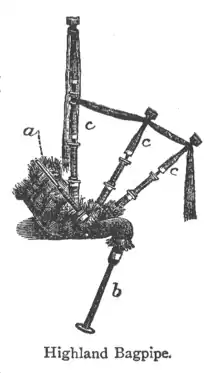Bagpipe theorem
In mathematics, the bagpipe theorem of Peter Nyikos (1984) describes the structure of the connected (but possibly non-paracompact) ω-bounded surfaces by showing that they are "bagpipes": the connected sum of a compact "bag" with several "long pipes".

Statement
A space is called ω-bounded if the closure of every countable set is compact. For example, the long line and the closed long ray are ω-bounded but not compact. When restricted to a metric space ω-boundedness is equivalent to compactness.
The bagpipe theorem states that every ω-bounded connected surface is the connected sum of a compact connected surface and a finite number of long pipes. A long pipe is roughly an increasing union of ω1 copies of the half-open cylinder . There are different isomorphism classes of long pipes. Two examples of long pipes are the product of a circle with a closed long ray (long at one end), and the "long plane" (a product of two long lines which are long at both ends) with an open disk removed. There are many examples of surfaces that are not ω-bounded, such as the Prüfer manifold.
References
- Nyikos, Peter (1984), "The theory of nonmetrizable manifolds", Handbook of set-theoretic topology, Amsterdam: North-Holland, pp. 633–684, MR 0776633